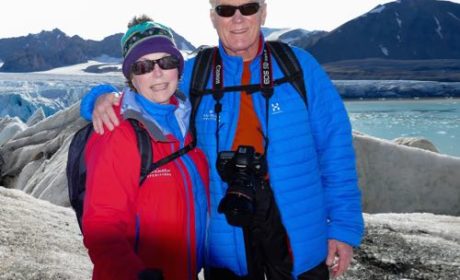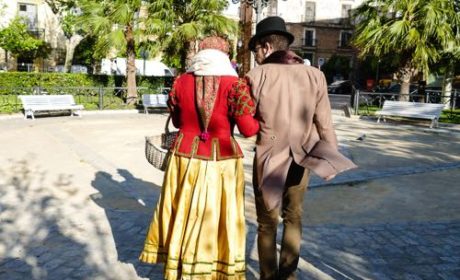If you’re looking for a South Pacific cruise excursion that’s totally off-the-beaten-path, welcome to Fanning Island. Boomer travelers won’t find stores, tours or any services, but they will experience welcoming residents living on a coral atoll with a turquoise-hued lagoon that screams tropical paradise.

While the island offers scenic eye candy, it’s not always a paradise for those who live here. Life on Fanning Island may appear simple but it’s also a hardscrabble existence.
With no power grid or indoor plumbing, residents rely on generators, water catchment basins and shallow, fresh water wells. A supply ship visits two to three times per year.
Approximately (the numbers change depending on the source) 1900 islanders reside in 8 villages scattered around the atoll. They depend on the sea for fish and also live off the land by growing taro, pumpkin, and harvesting coconut and papaya. There is also some exportation of seaweed and copra.
How to get to Fanning Island

The majority of visitors arrive by ship while cruising on long, South Pacific itineraries. Fanning Island is usually included either before or after calling on Hawaii, which is about 1,000 miles to the north. From 2001 to 2007, Norwegian Cruise Lines included the atoll as a port on Hawaiian cruise routes.
Tabuaeran Atoll, Fanning’s official name, is part of the Northern Line island chain in the Republic of Kiribati. The remote island country consists of 33 coral atolls sprawled over one million square miles in the Pacific Ocean. You may know Kiribati as the Gilbert Islands.
So far, Alan and I have cruised to Fanning Island on three South Pacific cruises, the latest being on Crystal Serenity. During one visit, rough seas prevented tenders from navigating through the English Channel—the passage into the lagoon. But twice, we’ve had the pleasure of a complimentary cruise excursion to one of the most remote places on earth.
Experiencing a Fanning Island cruise ship excursion

As Alan and I disembark the tender at Paelau, a village that serves as Tabuaeran’s administrative center, a group of school children sits under a thatch roof pavilion singing a welcome song. We pause and listen to the harmonies.
If you’re taking photos or videos, or simply enjoying the music, show your appreciation by dropping a couple of dollars into the contribution bucket.
Nearby, an impromptu market offers a combination folk festival–craft show atmosphere. Residents dressed in native garb pose for enthusiastic photographers—for a fee—or stand behind tables piled with sea shell necklaces, grass baskets, wood carvings and other locally-made trinkets.
There is nothing else to purchase on Fanning Island—no food, drinks, or other services. The one exception is the local who offers $10 dollar sightseeing tours in a truck.

Alan and I usually walk a ways down the dusty road that’s to the left of the craft market looking for photography opportunities. Roosters scratch their way through brush filled with empty coconut shells. Children stand near the road, smiling shyly. Others pass by on bicycles accompanied by friendly dogs. Teenagers motor around us on small motorbikes.
As usually happens during our Fanning Island visits, it doesn’t take long before the strong sun combined with humidity—we’re only about 4 degrees from the equator—causes us to rethink the walk. Other cruise guests continue past us looking for a sandy beach for a relaxing swim in the lagoon.
Since there is no sanitation or septic system on the island, be aware that waste flows into the shallow lagoon. Looking at the beautiful water, you’d never realize it. Perhaps it won’t affect you but as they say, knowledge is key.
You’ll also see piles of trash scattered in the underbrush. It won’t ruin the experience but it’s sad to see.

Returning back to the central area, Alan and I continue our walk near a shed where boats are being repaired. There’s a small curve of a beach here that attracts cruise guests and staff. If you’d rather not swim, sitting near the lagoon under the shade of a tree is a pleasant way to spend a few minutes.
It’s possible to continue walking to the Pacific Ocean side of Fanning Island. One of our cruise friends actually walked over to swim there. However the surf is rough and he quickly changed his mind.

Before returning on the tender, Alan always hands me money to shop the craft tables. “I don’t care what you buy, or if we ever use the items, just spend all of this.” With no other services to purchase, it’s the only way to help out those living in a subsistence-level economy.
Cruise guests often bring small school items for the children like pencils, paper, and such. Others pack over-the-counter medical supplies. Bringing water filtration pens is another great idea. The problem with this approach is that the passage into the lagoon may be too rough to visit Fanning Island so your supplies might not reach their intended recipients.
If you’re interested in helping the islanders, you’ll make the most impact by dropping your dollars into the contribution buckets or purchasing something from the craft tables.
Returning to Fanning Island

After two visits to Fanning Island in 2012 and 2018—where we actually made it ashore—I can say that little has changed. During our latest experience, the residents appear even more destitute than they originally did in 2012. And the craft market did not seem as vibrant as before.
However, if our cruise ship ever anchors off Fanning Island again, Alan and I will repeat the scenario—walk around, take photos and bring cash in the hopes that buying a few trinkets helps someone out. It’s not often as travelers that we have the opportunity to visit a region of the world so unaffected by technology.
Fanning Island facts

Accurate information about Fanning Island is hard to come by, even in the age of the Internet. During my search, I enjoyed reading the logs of yachting blogs, especially: Ride the Trades
And I also found the answers to a couple of my own questions:
Can I find Lodging on Fanning Island?
In my research for this article, I discovered that it is possible to stay here. True adventurers book rooms at Fanning Island Lodge through a tour provider. They’ll experience shared bathrooms, locally caught fish for dinner with daily activities ranging from fishing, surfing, snorkeling to visiting the villages.
Guests arrive by a private hour-long charter from Christmas Island, which is a 3-hour flight from Honolulu. The fishing, especially, is rumored to be outstanding.
Is Fanning Island historically important?

Fanning Island history goes back to the Polynesians. Artifacts have been discovered indicating that Polynesians stopped at Fanning Island on their way to explore the Hawaiian Islands. But they were long gone by the time American ship captain, Edmund Fanning, reached the island in 1798.
While some of WWII’s bloodies battles were fought on the atolls of Kiribati, especially on Tarawa, Butaritari and Abemama, Fanning Island escaped the carnage. However during WWI, a German ship shelled the atoll’s cable station severely damaging it. Soldiers came ashore and successfully cut the undersea communications cable, part of the All Red Line that connected Australia, New Zealand and Canada to Great Britain. Two weeks later the cable was repaired, reestablishing communications.
Will the Republic of Kiribati move to Fiji?

Today, Fanning Island, like the rest of Kiribati, is the canary in the coal mine of climate change, no matter how we agree or disagree upon the cause. The island’s highest point is 6’ above the high tide mark, putting it at rising from rising ocean water.
In 2014, Kiribati completed the purchase of 20 square kilometers on the island of Vanua Levu in Fiji for the relocation of residents in case the coral atolls, including Tabuaeran, become unlivable. But there are some concerns about that approach.
Is it realistic to think that residents used to relying on the ocean will adapt to farming on mountainous terrain? Is there enough land and infrastructure to adequately house the folks from Kiribati? What about the Fijian residents that already reside in the area?
There are many unanswered questions. If you’d like to learn more, I recommend this article from video journalist, Alan Toth, as well as an insightful post from the Australian aid and development experts at Devpolicy Blog.
Did you know that we publish a weekly broadcast with the latest articles from My Itchy Travel Feet, timely trip inspiration and travel deals? Subscribe by clicking here and checking the “Weekly Updates” box. We offer a monthly newsletter, too. Why not sign up for both?



